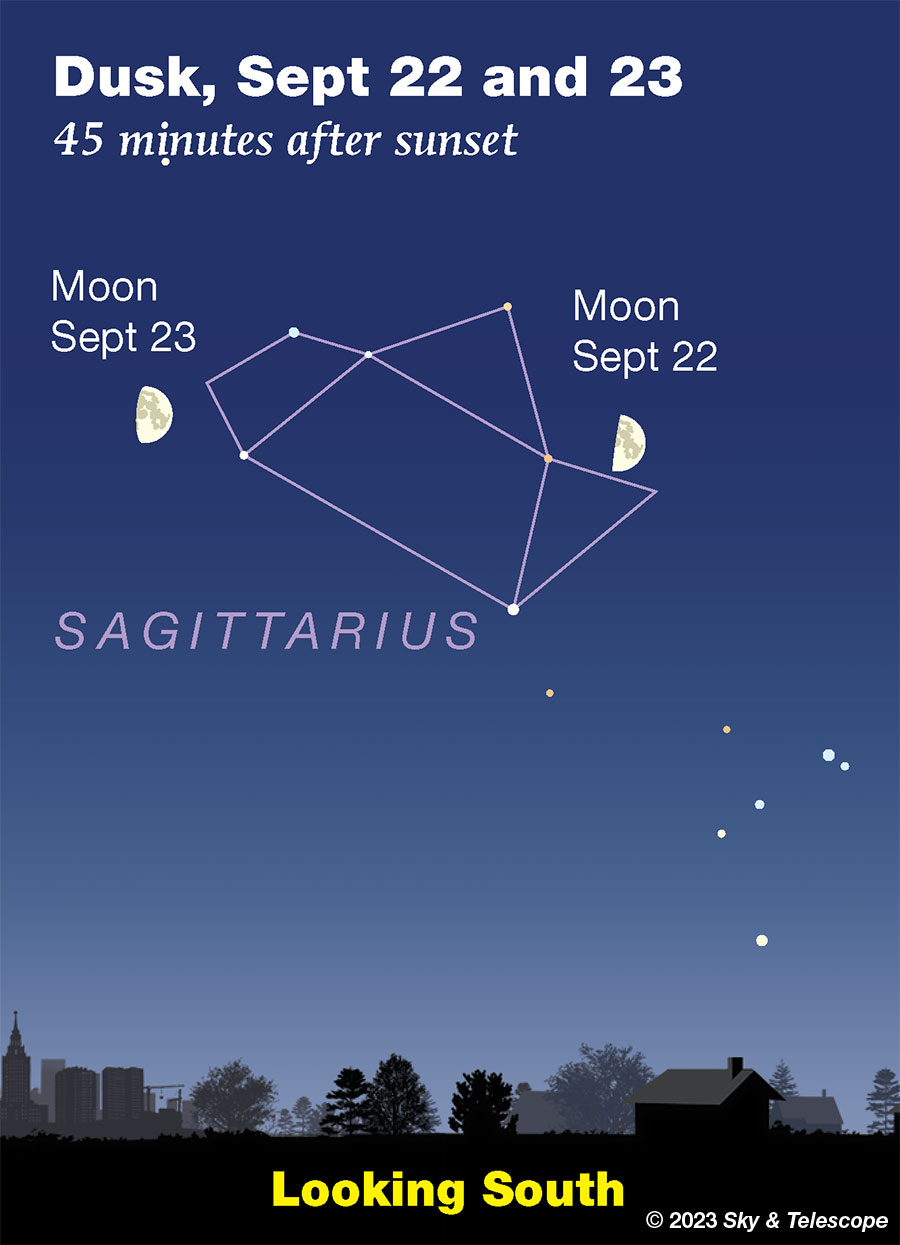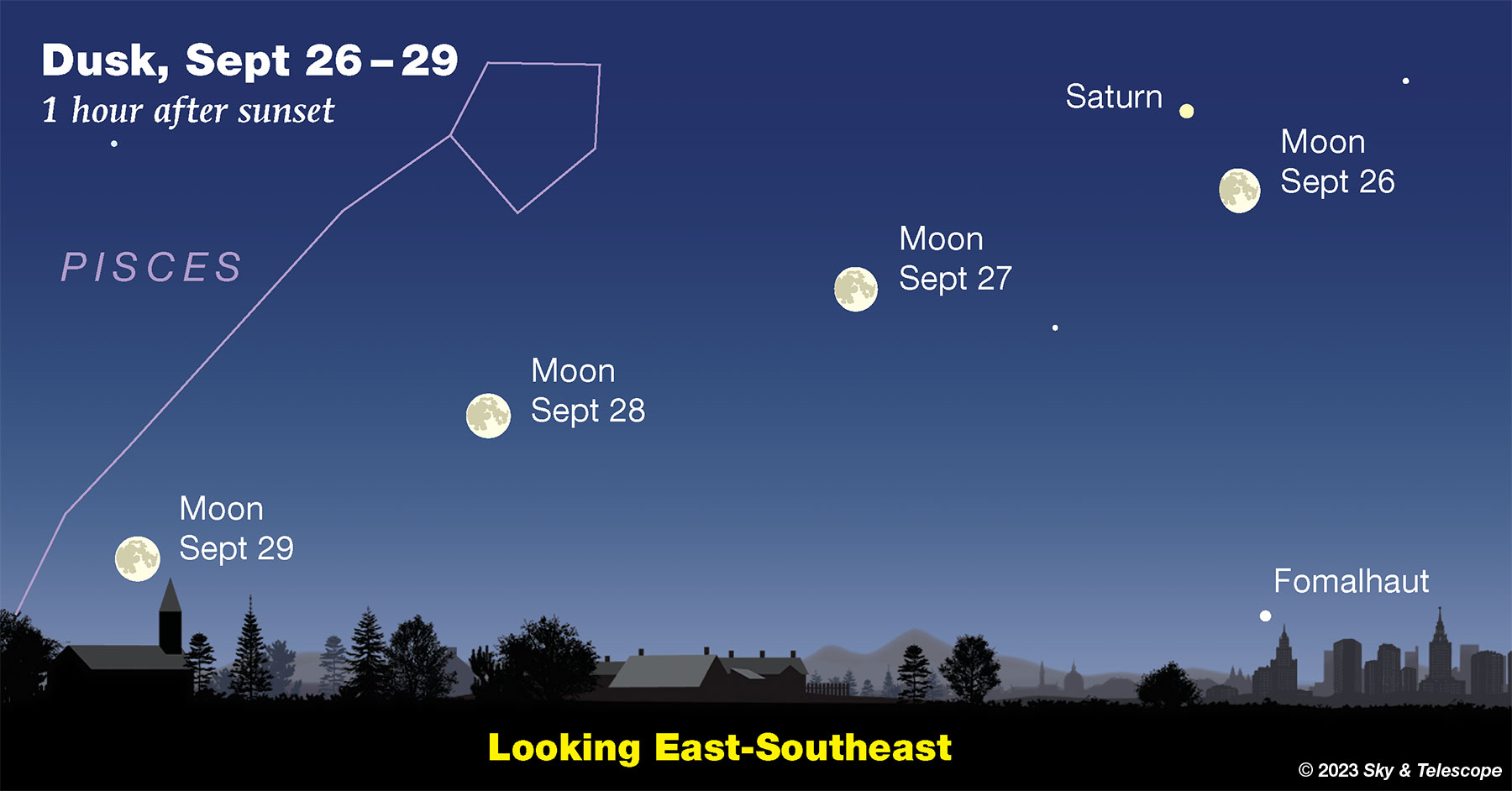FRIDAY,SEPTEMBER 22
¦ Tonight is equinox night.Fall beginsin the Northern Hemisphere at 2:50 a.m. tonight EDT, 11:50 p.m. PDT. That's when the Sun (which we're facing away from at the time) crosses the equator heading south for the season. The days keep getting shorter.
¦ Coincidentally, when summer turns to fall is about when Deneb takes over from brighter Vega as the zenith star shortly after nightfall (for skywatchers at mid-northern latitudes).
¦ First-quarter Moon; exactly so at 3:32 p.m. EDT. After dark it's just over the spout of the Sagittarius Teapot, as shown below (for North American observers). If you're in the Pacific time zone, the Moon sets close to the time of the equinox.
 Every 24 hours the Moon moves about 13° east along its orbit with respect to the stars. That's the distance from the spout to the handle of the Sagittarius Teapot.SATURDAY,SEPTEMBER 23 Every 24 hours the Moon moves about 13° east along its orbit with respect to the stars. That's the distance from the spout to the handle of the Sagittarius Teapot.SATURDAY,SEPTEMBER 23
¦ Now the Moon shines by the Teapot's handle, as shown above.
SUNDAY,SEPTEMBER 24
¦ High above the Moon this evening, by 3 or 4 fists at arm's length, shines Altair, the southernmost star of the Summer Triangle. The other two, Vega and lesser Deneb, are nearly overhead.
MONDAY,SEPTEMBER 25
¦ By 10 or 11 p.m. bright Jupiter is high and shines precisely east. (The exact time of that depends on your location.)
Look lower left of Jupiter, by about 1½ fists at arm's length, for the Pleiades.
A similar distance below the Pleiades, Aldebaran has risen or soon will.
Nearly three fists left of the Pleiades shines Capella, second in brightness to Jupiter.
TUESDAY,SEPTEMBER 26
¦ Look a little upper left of the Moon early this evening for Saturn, as shown below. By mid- to late evening Saturn stands straight above the Moon.
 The gibbous Moon passes under Saturn as it waxes toward full.WEDNESDAY,SEPTEMBER 27 The gibbous Moon passes under Saturn as it waxes toward full.WEDNESDAY,SEPTEMBER 27
¦ This is the time of year when, by mid-evening, the dim Little Dipper in the north "dumps water" into the bowl of the Big Dipper way down below. The Big Dipper will dump it back in the evenings of spring.
THURSDAY,SEPTEMBER 28
¦ Full Moon tonight and tomorrow. It's exactly full at 5:58 a.m. Friday morning EDT, between those two evenings.
¦ Arcturus shines in the west as twilight fades away. Capella, equally bright, is barely rising in the north-northeast (depending on your latitude; the farther north you are the higher it will be.) They're both magnitude 0.
Later in the evening, around 9 p.m., Arcturus and Capella shine at the same height. When will this happen? That depends on both your latitude and longitude.
When it does, turn around and look low in the south-southeast, far lower right of the bright Moon. There will be 1st-magnitude Fomalhaut at about the same height too — exactly so if you're at latitude 43° north (Boston, Buffalo, Milwaukee, Boise, Eugene). Seen from south of that latitude, Fomalhaut will appear higher than Capella and Arcturus are. Seen from north of there, it will be lower.
That bright light more than a third of the way from Capella to Fomalhaut is Jupiter.
Higher above Fomalhaut is Saturn, glowing steadily with a pale yellowish tint.
FRIDAY,SEPTEMBER 29
¦ Even as the stars come out in late twilight, Cassiopeia is already higher in the northeast than the sinking Big Dipper is in the northwest. Later in the evening, Cassiopeia's broad W pattern wheels higher and stands on end (its fainter end).
¦ Also in early evening, look above the bright Moon to see if you can make out the Great Square of Pegasus through the moonlight. It's balancing on one corner, making it the Great Diamond of Pegasus? The line from its top corner through its bottom corner points down at the Moon.
SATURDAY,SEPTEMBER 30
¦ Vega is the brightest star very high in the west after nightfall. Arcturus, equally bright, is getting low in the west-northwest.
The brightest star in the vast expanse between them, about a third of the way from Vega down toward Arcturus, is Alphecca, magnitude 2.2 — the crown jewel of Corona Borealis. Alphecca is a 17-day eclipsing binary, but its brightness dips are too slight for the eye to see reliably.
SUNDAY,OCTOBER 1
¦ Cygnus the Swan floats nearly straight overhead these evenings. Its brightest stars form the big Northern Cross. When you face southwest and crane your head up, the cross appears to stand upright. It's about two fists at arm's length tall, with Deneb as its top. Or to put it another way, when you face that direction the Swan appears to be diving straight down. Migrating away for fall? |




